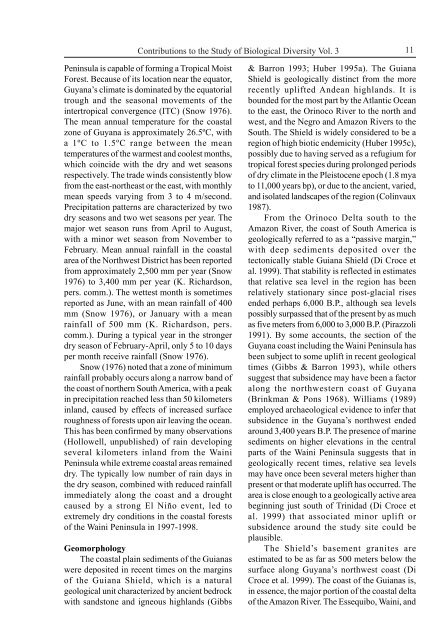Plant Community Structure, Fire Disturbance, and Recovery in ...
Plant Community Structure, Fire Disturbance, and Recovery in ...
Plant Community Structure, Fire Disturbance, and Recovery in ...
Create successful ePaper yourself
Turn your PDF publications into a flip-book with our unique Google optimized e-Paper software.
Contributions to the Study of Biological Diversity Vol. 3<br />
Pen<strong>in</strong>sula is capable of form<strong>in</strong>g a Tropical Moist<br />
Forest. Because of its location near the equator,<br />
Guyana’s climate is dom<strong>in</strong>ated by the equatorial<br />
trough <strong>and</strong> the seasonal movements of the<br />
<strong>in</strong>tertropical convergence (ITC) (Snow 1976).<br />
The mean annual temperature for the coastal<br />
zone of Guyana is approximately 26.5ºC, with<br />
a 1ºC to 1.5ºC range between the mean<br />
temperatures of the warmest <strong>and</strong> coolest months,<br />
which co<strong>in</strong>cide with the dry <strong>and</strong> wet seasons<br />
respectively. The trade w<strong>in</strong>ds consistently blow<br />
from the east-northeast or the east, with monthly<br />
mean speeds vary<strong>in</strong>g from 3 to 4 m/second.<br />
Precipitation patterns are characterized by two<br />
dry seasons <strong>and</strong> two wet seasons per year. The<br />
major wet season runs from April to August,<br />
with a m<strong>in</strong>or wet season from November to<br />
February. Mean annual ra<strong>in</strong>fall <strong>in</strong> the coastal<br />
area of the Northwest District has been reported<br />
from approximately 2,500 mm per year (Snow<br />
1976) to 3,400 mm per year (K. Richardson,<br />
pers. comm.). The wettest month is sometimes<br />
reported as June, with an mean ra<strong>in</strong>fall of 400<br />
mm (Snow 1976), or January with a mean<br />
ra<strong>in</strong>fall of 500 mm (K. Richardson, pers.<br />
comm.). Dur<strong>in</strong>g a typical year <strong>in</strong> the stronger<br />
dry season of February-April, only 5 to 10 days<br />
per month receive ra<strong>in</strong>fall (Snow 1976).<br />
Snow (1976) noted that a zone of m<strong>in</strong>imum<br />
ra<strong>in</strong>fall probably occurs along a narrow b<strong>and</strong> of<br />
the coast of northern South America, with a peak<br />
<strong>in</strong> precipitation reached less than 50 kilometers<br />
<strong>in</strong>l<strong>and</strong>, caused by effects of <strong>in</strong>creased surface<br />
roughness of forests upon air leav<strong>in</strong>g the ocean.<br />
This has been confirmed by many observations<br />
(Hollowell, unpublished) of ra<strong>in</strong> develop<strong>in</strong>g<br />
several kilometers <strong>in</strong>l<strong>and</strong> from the Wa<strong>in</strong>i<br />
Pen<strong>in</strong>sula while extreme coastal areas rema<strong>in</strong>ed<br />
dry. The typically low number of ra<strong>in</strong> days <strong>in</strong><br />
the dry season, comb<strong>in</strong>ed with reduced ra<strong>in</strong>fall<br />
immediately along the coast <strong>and</strong> a drought<br />
caused by a strong El Niño event, led to<br />
extremely dry conditions <strong>in</strong> the coastal forests<br />
of the Wa<strong>in</strong>i Pen<strong>in</strong>sula <strong>in</strong> 1997-1998.<br />
Geomorphology<br />
The coastal pla<strong>in</strong> sediments of the Guianas<br />
were deposited <strong>in</strong> recent times on the marg<strong>in</strong>s<br />
of the Guiana Shield, which is a natural<br />
geological unit characterized by ancient bedrock<br />
with s<strong>and</strong>stone <strong>and</strong> igneous highl<strong>and</strong>s (Gibbs<br />
11<br />
& Barron 1993; Huber 1995a). The Guiana<br />
Shield is geologically dist<strong>in</strong>ct from the more<br />
recently uplifted Andean highl<strong>and</strong>s. It is<br />
bounded for the most part by the Atlantic Ocean<br />
to the east, the Or<strong>in</strong>oco River to the north <strong>and</strong><br />
west, <strong>and</strong> the Negro <strong>and</strong> Amazon Rivers to the<br />
South. The Shield is widely considered to be a<br />
region of high biotic endemicity (Huber 1995c),<br />
possibly due to hav<strong>in</strong>g served as a refugium for<br />
tropical forest species dur<strong>in</strong>g prolonged periods<br />
of dry climate <strong>in</strong> the Pleistocene epoch (1.8 mya<br />
to 11,000 years bp), or due to the ancient, varied,<br />
<strong>and</strong> isolated l<strong>and</strong>scapes of the region (Col<strong>in</strong>vaux<br />
1987).<br />
From the Or<strong>in</strong>oco Delta south to the<br />
Amazon River, the coast of South America is<br />
geologically referred to as a “passive marg<strong>in</strong>,”<br />
with deep sediments deposited over the<br />
tectonically stable Guiana Shield (Di Croce et<br />
al. 1999). That stability is reflected <strong>in</strong> estimates<br />
that relative sea level <strong>in</strong> the region has been<br />
relatively stationary s<strong>in</strong>ce post-glacial rises<br />
ended perhaps 6,000 B.P., although sea levels<br />
possibly surpassed that of the present by as much<br />
as five meters from 6,000 to 3,000 B.P. (Pirazzoli<br />
1991). By some accounts, the section of the<br />
Guyana coast <strong>in</strong>clud<strong>in</strong>g the Wa<strong>in</strong>i Pen<strong>in</strong>sula has<br />
been subject to some uplift <strong>in</strong> recent geological<br />
times (Gibbs & Barron 1993), while others<br />
suggest that subsidence may have been a factor<br />
along the northwestern coast of Guyana<br />
(Br<strong>in</strong>kman & Pons 1968). Williams (1989)<br />
employed archaeological evidence to <strong>in</strong>fer that<br />
subsidence <strong>in</strong> the Guyana’s northwest ended<br />
around 3,400 years B.P. The presence of mar<strong>in</strong>e<br />
sediments on higher elevations <strong>in</strong> the central<br />
parts of the Wa<strong>in</strong>i Pen<strong>in</strong>sula suggests that <strong>in</strong><br />
geologically recent times, relative sea levels<br />
may have once been several meters higher than<br />
present or that moderate uplift has occurred. The<br />
area is close enough to a geologically active area<br />
beg<strong>in</strong>n<strong>in</strong>g just south of Tr<strong>in</strong>idad (Di Croce et<br />
al. 1999) that associated m<strong>in</strong>or uplift or<br />
subsidence around the study site could be<br />
plausible.<br />
The Shield’s basement granites are<br />
estimated to be as far as 500 meters below the<br />
surface along Guyana’s northwest coast (Di<br />
Croce et al. 1999). The coast of the Guianas is,<br />
<strong>in</strong> essence, the major portion of the coastal delta<br />
of the Amazon River. The Essequibo, Wa<strong>in</strong>i, <strong>and</strong>
















